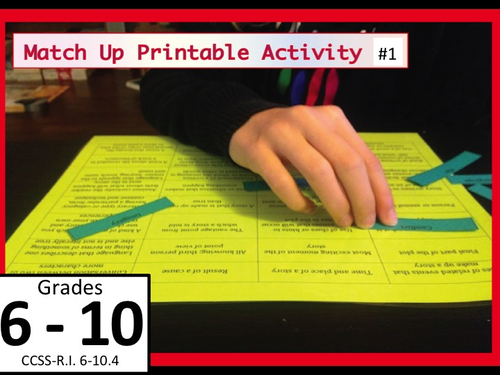

This Literary Terms Match-Up Game is effective, fun, and can be used over and over in the classroom!
Accompanied with an EATS lesson plan and following the Common Core RI.7.4., the "board" gives 28 definitions.
Literary terms included are: Dialogue, Figurative language, Plot Inference, Genre, Suspense, Imagery, Theme, Flashback, Irony,
Effect, Omniscient, Point of View, Fiction, Cause, Paraphrase, Retelling, Conflict, Setting, Climax, Foreshadowing, Predict, Stanza, Tone, Mood, Main idea, Resolution,Character, Drama, Non-fiction, Narration, Onomatopoeia. The answer key is provided not only to make life easier, but to allow students to check their own work.
At the beginning of the year, have students work in groups to match the term to the definition. As the year progresses, use it as a review to see if the students learned the material. Eventually, students will complete the activity individually.
It is a great activity for the end of the year, too. You will be impressed how much the students have learned. What took them 20 minutes at the beginning of the year now takes 5 minutes for many students!
Throughout the year, I use this as a "filler" when the power goes out or a bomb threat is called in (Yes, it happens!) without wasting students' time.
Once, my principal unexpectedly visited my classroom while the students were working on this activity- and he asked if I made this myself. He was impressed. Yay! (The happiness we teachers get from a pat on the back...)
I suggest making copies of the game pieces with colored paper so the words stand out more. (Mine was printed on colored paper- in the picture. Laminating the game board and pieces (hint: BEFORE you cut them apart) is a really good idea as well!
I also print out copies and give at Open House or at conferences. My students' parents were very grateful!
Accompanied with an EATS lesson plan and following the Common Core RI.7.4., the "board" gives 28 definitions.
Literary terms included are: Dialogue, Figurative language, Plot Inference, Genre, Suspense, Imagery, Theme, Flashback, Irony,
Effect, Omniscient, Point of View, Fiction, Cause, Paraphrase, Retelling, Conflict, Setting, Climax, Foreshadowing, Predict, Stanza, Tone, Mood, Main idea, Resolution,Character, Drama, Non-fiction, Narration, Onomatopoeia. The answer key is provided not only to make life easier, but to allow students to check their own work.
At the beginning of the year, have students work in groups to match the term to the definition. As the year progresses, use it as a review to see if the students learned the material. Eventually, students will complete the activity individually.
It is a great activity for the end of the year, too. You will be impressed how much the students have learned. What took them 20 minutes at the beginning of the year now takes 5 minutes for many students!
Throughout the year, I use this as a "filler" when the power goes out or a bomb threat is called in (Yes, it happens!) without wasting students' time.
Once, my principal unexpectedly visited my classroom while the students were working on this activity- and he asked if I made this myself. He was impressed. Yay! (The happiness we teachers get from a pat on the back...)
I suggest making copies of the game pieces with colored paper so the words stand out more. (Mine was printed on colored paper- in the picture. Laminating the game board and pieces (hint: BEFORE you cut them apart) is a really good idea as well!
I also print out copies and give at Open House or at conferences. My students' parents were very grateful!
Something went wrong, please try again later.
This resource hasn't been reviewed yet
To ensure quality for our reviews, only customers who have purchased this resource can review it
Report this resourceto let us know if it violates our terms and conditions.
Our customer service team will review your report and will be in touch.
$3.00
